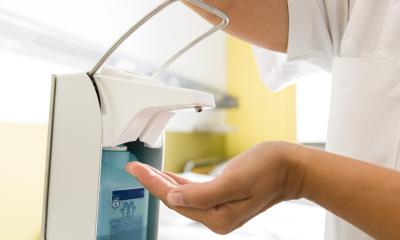Success in MRSA control
By Professor Jan Kluytmans MD, of the Microbiology and Infection Control Laboratory, Amphia Hospital, Breda

In 1996, Prof. Kluytmans thesis for his PhD in clinical microbiology on Nasal carriage of Staphylococcus aureus: the key to preventing staphylococcal disease. And, today, his scientific interest is mainly in the epidemiology and control of nosocomial infections, with a special emphasis on Staphylococcus aureus. He is involved in many guidelines on infection control, especially those dealing with MRSA control, and has had over 100 papers published in peer-reviewed journals
Staphylococcus aureus is the most common cause of nosocomial infections and the consequences of S. aureus infections are significant. A recent study in the USA, including over 7 million hospital admissions, estimated that 0.8% of all patients suffered S. aureus infection, corresponding to a total of nearly 300,000 patients in all US hospitals. After controlling for confounders, the annual impact in the US was estimated to be 2.7 million additional days in the hospital, $ 9.5 billion excess costs and 12,000 in-patient deaths.
A major problem is the emergence of methicillin-resistant strains of S. aureus (MRSA). First reported in 1961, MRSA has become increasingly prevalent in hospitals since the 1980s and is now endemic in many hospitals globally, with resistance being present in up to 60% of all S. aureus infections. These resistant micro-organisms are difficult to threat and several studies have found that there is increased morbidity and mortality associated with MRSA infections. In a systematic review on patients with bacteremia, Cosgrove et al estimated that MRSA was associated with nearly twice higher mortality than MSSA. In addition to this increased severity of disease, there is also an increase in the absolute number of affected patients. A study in England and Wales showed that, after the introduction of MRSA, the absolute number of patients suffering from S. aureus bacteremia increased with the number of patients suffering from MRSA.
Because of the serious consequences associated with the spread of MRSA control is of utmost importance. Clonal dissemination is the mechanism for the spread of MRSA, therefore control of MRSA largely depends on the prevention of transmission from known carriers. Antibiotic usage will probably play a role by applying selective pressure that gives resistant strains an advantage over their susceptible ancestors, but control of antibiotic usage alone will not control the spread of MRSA. An active policy to find carriers of MRSA and prevent further transmission from these carriers is the core measure for the control MRSA.
Search and destroy
For many years The Netherlands has maintained a very low incidence (<1%), despite a high incidence in the surrounding countries, by using a ‘Search and Destroy’ (S&D) strategy to control MRSA.
The key elements of the S&D strategy are (1) the early recognition of carriers of MRSA, (2) isolation of (suspected) carriers of MRSA, (3) eradication of carriage and (4) a ‘zero tolerance’ approach. These elements will be described in more detail below.
The first outbreaks of MRSA occurred in the 1980’s and were traced to patients who had been hospitalised abroad. The outbreaks were controlled by applying S&D. After these initial observations a national strategy was developed to isolate and screen patients who had been hospitalised abroad upon transfer to the Netherlands. Isolation measures were abandoned when the results of screening showed that no MRSA was present. In this way most cases of MRSA were detected and controlled in an early stage, although sporadically outbreaks occurred due to patients who were not identified at increased risk of carriage before.
In 1988 the Dutch Working Party on Infection Control (WIP) issued a guideline on the control of MRSA in hospitals. This guideline has been updated several times and still is the core element of the Dutch S&D strategy. It is available in Dutch and English at www.wip.nl. Along with the evolution of MRSA from the hospitals into nursing homes, and recently into the community, additional guidelines were developed for these settings as well. It should be noted that besides patients, also healthcare workers are included in contact tracing and, if they harbour MRSA, they are temporarily suspended from work.
Another aspect of the S&D policy that is critical to its success is the quality of the screening for MRSA. This includes not only that the right people should be screened, but also that the screening methods are reliable. For example, if only the nose is sampled a significant part of the carriers is left undetected. The guideline of the WIP recommends additional screening of the throat, the perineum and clinical sites if present. Also the laboratory methods used are essential and these have been incorporated in a specific guideline as well.
The implementation of the guidelines is the most important factor for the effectiveness. Compliance with guidelines on infection control in hospitals is generally low, and not easy to improve. The guidelines on MRSA in The Netherlands are very strict and therefore often debated. However, compliance with the guidelines is amazingly high. This is mainly due to a very active support and control by the Dutch infection control practioners. When patients are in isolation for MRSA, the wards are visited frequently to answer questions regarding the procedures and to audit if the appropriate control measures are taken. In addition, adherence to the guidelines is monitored by the Government (the Healthcare Inspectorate).
To monitor the effectiveness of the policy a national surveillance has been performed for over 20 years. This includes that a representative isolate of all newly identified carriers of MRSA is sent to the National Institute of Public Health and Environmental Protection (RIVM) where further typing is performed (www.rivm.nl/mrsa).
Threats to the strategy are mainly the emergence of MRSA in the community and more recently in pig farmers. The good news is the availability of rapid tests to detect MRSA. A reliable culture method takes on average four days before it can be considered negative. Molecular tests that can detect the presence of MRSA within two hours are now available and these will greatly improve the effectiveness of the control policy, although backup cultures remain necessary.
In conclusion, control of MRSA is successfully maintained using the S&D strategy. Although the principles of S&D are relatively simple, it involves complex interactions in the modern healthcare setting. Besides active tracing of carriers of MRSA and subsequent isolation of proven carriers it is essential to have reliable laboratory methods to remain in control of MRSA.
Further details and references: jkluytmans@amphia.nl
26.06.2007





